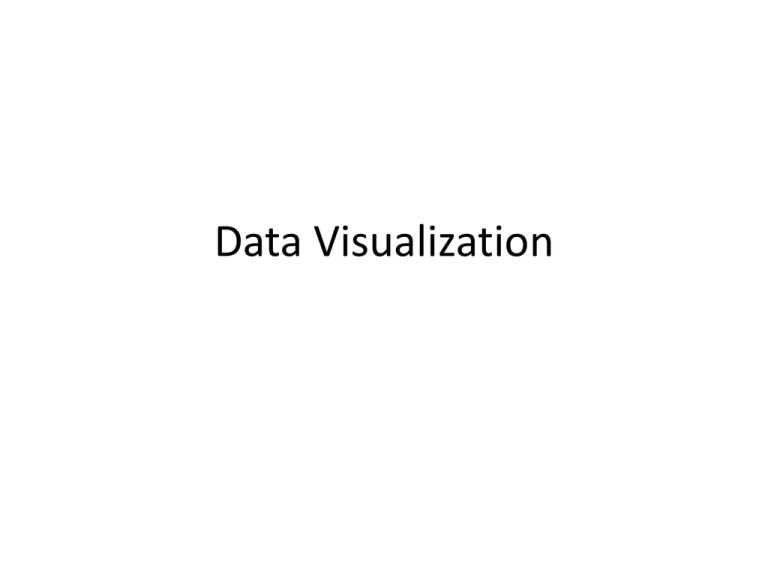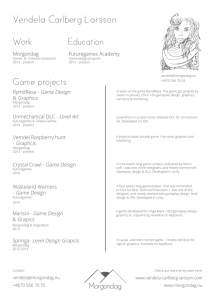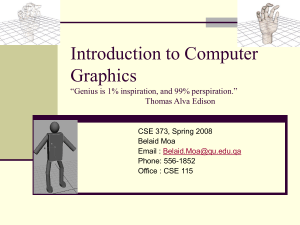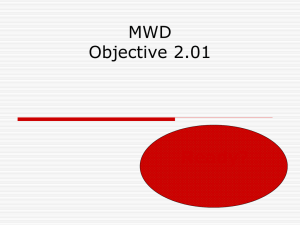Lecture Slides
advertisement

Data Visualization Lies, Damn Lies, and Bad Graphs Lies, Damn Lies, and Bad Graphs Lies, Damn Lies, and Bad Graphs Visual Medium • Reports – Paper (static, with time) – Web (dynamic and interactive) • Presentations (static and dynamic) “It’s not just about producing graphics for publication,” Aldhous explains. “It’s about playing around and making a bunch of graphics that help you explore your data.This kind of graphical analysis is a really useful way to help you understand what you’re dealing with, because if you can’t see it, you can’t really understand it. But when you start graphing it out, you can really see what you’ve got.” Four sets of data with the same correlation of 0.816 Percent Blue relative to Red? Percent Blue relative to Red? 2 1 Percent Water 80 75 70 65 60 55 50 45 40 35 30 25 20 15 10 5 0 body brain blood Percent Water 85 80 75 70 65 60 55 50 45 40 35 30 25 20 15 10 5 0 body brain blood Percent Water 100 75 50 25 0 body brain blood Bad Better Even Better* 0 5 10 15 Too Little About Right Too Much National Spending to Deal with Drug Addiction 20 25 30 0 5 10 15 20 25 30 35 Too Little About Right Too Much Male Female National Spending to Deal with Drug Addiction 40 National Spending to Deal with Drug Addiction Too Little Female About Right Male Too Much - 10 20 30 40 National Spending to Deal with Drug Addiction Female Too Little About Right Too Much Male 0% 20% 40% 60% 80% 100% #Introduction #History of Plots #The Explanatory Power of Graphics #Basic Philosophy of Approach #Graphical Integrity #Data Densities #Data Compression #Multifunctioning Graphical Elements #Maximize data-ink; minimize non-data ink #Small Multiples #Chartjunk #Colors #General Philosophy for Increasing Data Comprehension #Techniques for Increasing Data Comprehension #When NOT to Use Graphics #Aesthetics Chartjunk and Graphics Integrity Types of chartjunk • Chartjunk are non-data-ink or redundant data-ink decoration • Unintended Optical Art (Moiré vibration) • The Grid • The Duck: Self-promoting Graphics Unintended Optical Art • Mainly rely on moiré effects – Distracting appearance of vibration and movement – The most common form of graphical clutter Moiré Vibrations The Grid • Dark grid lines are chartjunk • The grid should usually be muted or completely supressed The Grid (cont’d) • Marey’s train schedule The Duck • Self-promoting graphics: when the data measures become design elements Duck Examples "In our excitement to produce what we could only make before with great effort, many of us have lost sight of the real purpose of quantitative displays — to provide the reader with important, meaningful, and useful insight." — Stephen Few Graphical Integrity • Graphical excellence begins with telling the truth about the data Some examples of Lie Two Principles • The representation of numbers, as physically measured on the surface of the graphics, should be directly proportional to the numerical quantities represented • Clear, detailed and thorough labeling should be used to defeat distoration Violating rule 1 18 miles/gallon: 0.6 inches; 27.5miles/gallon: 5.3 inches Lie Factor • Rule 1 can be measured by Lie factor size of effect shown in graphics Lie Factor = size of effect in data • Lie Factor equal to one is ideal • The previous slide has a lie factor of 14.8 Design and Data Variation • Show data variation, not design variation • 1973-1978: one vertical inch equals to $8.00. In 1979, One vertical inch equals $3-4 • 1973-1978: one horzontal inch equals 3.7 years, while 1979 equals 0.57 year Example • Lie factor: 9.5 • The price of oil is inflated so need to be repaired. Government Spending • Tricks to exaggerate the growth of spending Real Government Spending Tricks to exaggerate the growth of spending Visual Area and Numerical Measure • Tricking the reviewer with design variation is to use areas to show 1D data Lie factor: 2.8 Content is Essential • Graphics must not quote data out of context Content is Essential Graphics must not quote data out of context On Using Color… Rule #3: Use color only when needed to serve a particular communication goal. 0 50 100 150 Japan Greece Italy Belgium Portugal Hungary United… Austria France Netherlands Poland Iceland United States Turkey Germany Sweden Spain Denmark Finland Korea Canada Ireland Czech Republic Slovak Republic Mexico Switzerland New Zealand Norway Luxembourg Australia 2008 Debt to GDP Ratio for OECD 200 Picking Color Schemes http://colorbrewer2.org/ http://kuler.adobe.com Stop Visually Assaulting Me • http://fosslien.com/rules/ The principles • The representation of numbers, as physically measured on the surface of graphics, should be proportionally to the numerical quantities represented • Use clear and detailed labeling • Show data variation, not design variation • The number of information-carrying dimensions depicted should not exceed the number of dimensions in the data (2 dimensions of data 2 D, 2 dimensions 3 D) • Graphics should not quote data out of context Why do graphics lie? • Lack of quantitative skills of professional artists • The doctrine that statistical data are boring • The doctrine that graphics are only for the unsophisticated readers Design is choice.The theory of the visual display of quantitative information consists of principles that generate design options and that guide choices among options. The principles should not be applied rigidly or in a peevish spirit; they are not logically or mathematically certain; and it is better to violate any principle than to place graceless or inelegant marks on paper. — Edward Tufte,The Visual Display of Quantitative Information Word Cloud Spine Plot / Matrix Chart Bullet Graph Data dense. Each bar communicates a piece of data. Bullet Graph Bullet Graph Choropleth “Heat Map” RED STATE BLUE STATE PURPLE STATE Dynamic Charts Leisure Time Spent biking 125 hiking 40 reading 30 singing 25 dancing 10 cleaning 0 Avoid defaults in Excel • Show the data • Data dense Maximize Data Ink Ratio Minimize Non-Data Ink Eliminate Chart Junk Streamline Placement










